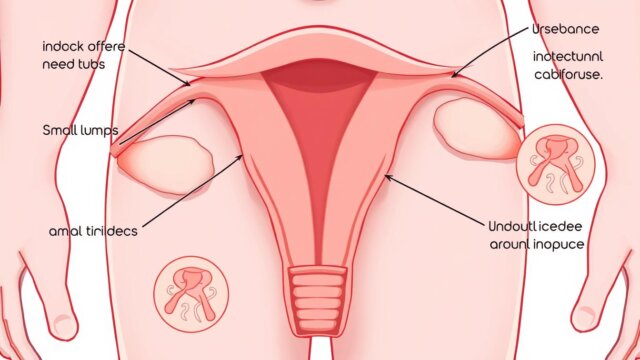FTC disclaimer: This post may contains affiliate links and we will be compensated if you click on a link and make a purchase.
Cancer is the second-leading cause of death worldwide, claiming millions of lives each year. But the good news is that survival rates for many cancers are getting better. This is thanks to better cancer screening, treatment, and prevention. This article will dive deep into malignancy, covering its definition, symptoms, causes, diagnosis, and treatment.
Cancer is a disease where abnormal cells grow and spread. These cells can destroy normal body tissue. Cancer can spread through a process called metastasis. With 1 in 3 people in the United States affected by cancer, it’s key to understand this disease for our health.
Key Takeaways
- Cancer is the second-leading cause of death worldwide, but survival rates are improving due to advancements in cancer screening, treatment, and prevention.
- Cancer is characterized by the development of abnormal cells that divide uncontrollably and can spread throughout the body.
- Factors like age, habits, family history, and genetic mutations can increase the risk of developing cancer.
- Cancer can be diagnosed through various tests, including biopsies, and is staged based on the extent of its spread.
- Treatment options for cancer include surgery, radiation therapy, and chemotherapy, with the goal of curing the disease or managing its symptoms.
What is Malignancy?
Malignancy means cancer cells that can spread or grow in other parts of the body. These cells grow too fast and change their DNA, making them hard to treat. Doctors like Erika Moore, Ph.D., from the University of Florida, are working hard to find better treatments.
Definition and Overview of Cancer
Cancer is when cells grow and spread without control. The National Cancer Institute (NCI) has a big list of cancer terms, including malignancy.
Types of Malignancy: Hematologic and Solid Tumors
Cancer can be in blood (hematologic) or solid tumors in organs or tissues. These cancers can grow and spread differently. They also react differently to treatments.
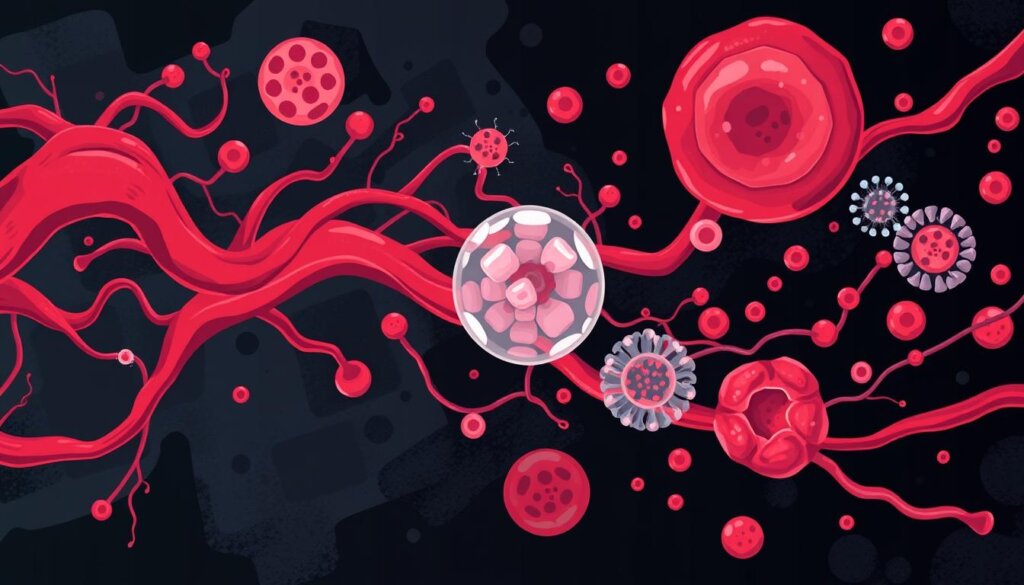
“Malignant cells exhibit fast, uncontrolled growth and changes in their genetic makeup, making them resistant to treatment.” –
Some cancer cells can come back after treatment. Some cancers have thousands to hundreds of thousands of genetic changes. Tazemetostat is being tested for a rare nerve tumor.
Type of Cancer | Frequency | Mortality |
|---|---|---|
Malignancy (Overall) | 442.4 per 100,000 per year | Approximately 10 million deaths per year |
Multiple Myeloma | 20 out of 1 million people per year | N/A |
Osteosarcoma | 2-3 people per million annually | N/A |
Ewing’s Sarcoma | Primarily affects individuals aged 5-20 | N/A |
Chondrosarcoma | Most common in patients aged 40-70 | N/A |
Malignant tumors often have many different types of cells. People who get organ transplants are at higher risk of getting cancer.
Knowing about different types of malignancy helps doctors find and treat cancer better.
Symptoms of Malignancy
General Signs and Symptoms of Cancer
Cancer symptoms can be different for each type and where it is. Common signs include feeling very tired, unexpected weight changes, and skin issues. Other signs are a persistent cough, trouble breathing, and swallowing problems.
Unexplained bleeding or bruising, fever, and extreme tiredness are also signs. These symptoms can be from cancer or other health issues. It’s key to see a doctor if you notice any big changes or symptoms that won’t go away.
Regular check-ups and tests can help find cancer early. This can lead to better treatment chances.
Some common cancer signs are heavy night sweats, unexplained fever, and feeling very tired. Unexplained bleeding, pain, weight loss, and unusual lumps are also signs. If you notice new or worsening symptoms, see a doctor right away.
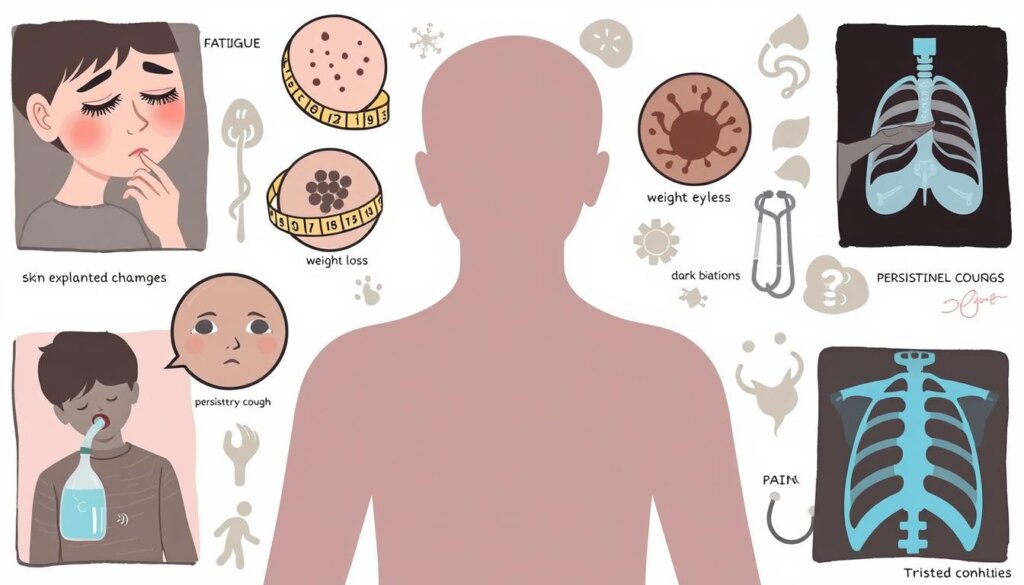
“Most signs and symptoms that may indicate cancer can also be caused by other conditions.”
Common Cancer Symptoms | Possible Underlying Causes |
|---|---|
Fatigue | Anemia, depression, hypothyroidism |
Unexplained Weight Loss | Cancer, thyroid disorders, diabetes |
Persistent Cough or Difficulty Breathing | Lung cancer, asthma, COPD |
Unexplained Bleeding or Bruising | Leukemia, platelet disorders, liver disease |
Unusual Lumps or Swellings | Cancer, benign tumors, cysts |
The symptoms of cancer can vary a lot. They depend on the cancer’s size, location, and how it affects nearby organs. Remember, some symptoms can mean cancer, but they can also mean other health issues. Always talk to a doctor for a proper diagnosis and treatment.
Causes of Malignancy
Cancer is a complex disease caused by genetic changes. These changes lead to uncontrolled cell growth and division. Understanding cancer causes is key for prevention and early detection.
Gene Mutations and Their Role in Cancer Development
Cancer is mainly driven by mutations in genes that control cell growth. These mutations can be inherited or caused by exposure to harmful substances like radiation or chemicals. Genes like TP53, KRAS, and BRAF are often linked to different cancer types.
Risk Factors for Developing Cancer
Many factors can raise the risk of getting cancer. These include getting older, unhealthy lifestyle choices, and genetic predisposition. Exposure to environmental carcinogens also plays a role. Cancer often results from a mix of risk factors, not just one.
Lung cancer is the deadliest, causing nearly 30% of cancer deaths in the US. The risk of colon cancer also grows significantly with age.
Knowing the causes and risk factors helps people take steps to lower their risk. This can improve their health.
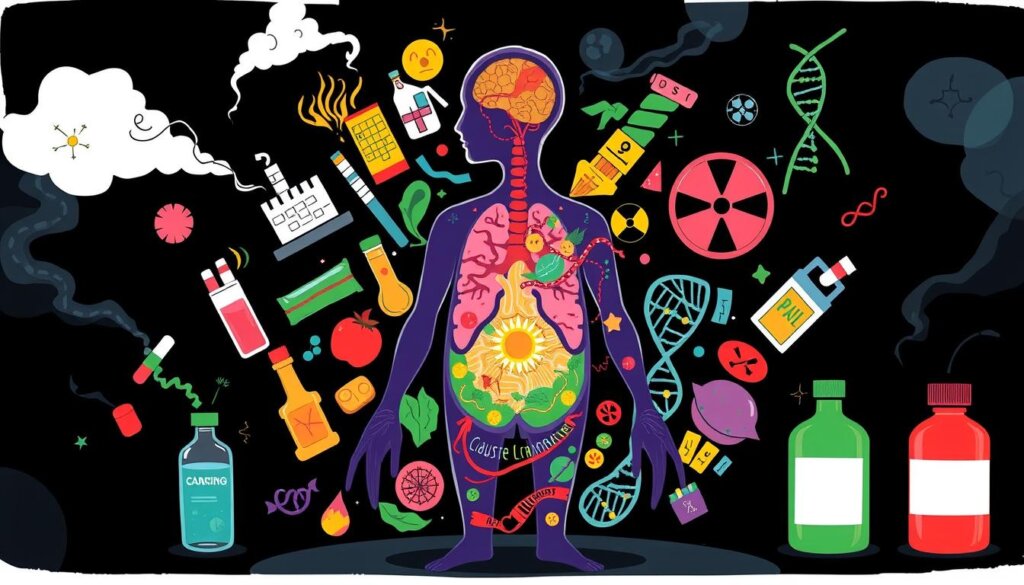
“Cancer risk increases with prolonged exposure to risk factors, and the development of cancer typically occurs over many years of exposure to various risk factors.”
It’s crucial to trust information from reliable sources. Organizations like the International Agency for Cancer Research and the US National Toxicology Program provide accurate info on cancer causes and prevention.
Malignancy and Tumor Growth
Tumors can be either benign (non-cancerous) or malignant (cancerous). Benign tumors grow slowly and don’t spread. Malignant tumors grow fast and can spread to other parts of the body through the bloodstream or lymphatic system, a process known as metastasis.
Benign vs. Malignant Tumors
Benign tumors are less aggressive and less likely to be deadly. They are often contained within a boundary and don’t invade nearby tissues. Malignant tumors, on the other hand, grow quickly, invade nearby structures, and can spread to other parts of the body.
Metastasis: How Cancer Spreads
Metastasis is a key feature of malignant tumors that makes cancer deadly. Cancer cells break away, enter the bloodstream or lymphatic system, and travel to other parts of the body. There, they can form new tumors. Changes in cancer cells, like losing cell-to-cell adhesion, help them spread. They also secrete enzymes and form new blood vessels to grow.

It’s important to know the differences between benign and malignant tumors and how metastasis works. This knowledge helps doctors diagnose and treat cancer accurately.
Characteristic | Benign Tumors | Malignant Tumors |
|---|---|---|
Growth Rate | Slow | Rapid |
Invasion of Surrounding Tissues | Confined to Original Site | Invade and Destroy Nearby Tissues |
Metastasis | Do Not Metastasize | Metastasize to Other Parts of the Body |
Prognosis | Good | Poor |
“Cancer cells display a fundamental loss of the normal controls over cell division and cell death, leading to uncontrolled growth and the potential to spread to other tissues.”
Diagnosing Malignancy
When doctors think you might have cancer, they do many tests. These include physical exams and imaging like X-rays and CT scans. They also take biopsies to check the tissue. Knowing if you have cancer and how far it has spread is key to treating it right.
Blood tests can show how well your organs are working. A Complete Blood Count (CBC) helps find cancers like leukemia. It also checks your health during and after treatment. Tests like cytogenetic analysis and immunophenotyping help find and track blood cancers.
Liquid biopsy finds cancer cells in your blood early. Sputum cytology checks lung mucus for lung cancer. Tumor marker tests find substances from cancer cells to guide treatment. Urinalysis checks for signs of kidney and bladder cancers.
Imaging tests like CT scans and MRIs show cancer details. Biopsies are key for a sure cancer diagnosis.
Cancer screening can catch cancer early for some types. Many groups give advice on screening. Tests like CT scans and biopsies help find cancer.
Cancer stages are marked by numbers or Roman numerals. Treatments include surgery, chemo, and radiation.
“No alternative cancer treatments have been proved to cure cancer, but some alternative medicine options like acupuncture, hypnosis, massage, meditation, relaxation techniques, and yoga can help cope with cancer and its treatment.”
Support groups and talking to loved ones help with cancer.
Cancer Staging and Treatment Options
Understanding Cancer Stages
The stage of cancer is very important for treatment. The TNM system is used to classify cancer. It looks at the tumor size, lymph nodes, and if it has spread.
This helps doctors plan the best treatment and find clinical trials.
Cancer is also grouped into five stages: Stage 0 to Stage IV. Stage IV means the cancer has spread far. Doctors use more details like in situ or distant to describe cancer.
Knowing the stage helps doctors understand the cancer’s seriousness. It also helps predict survival chances. Each cancer type has its own staging system, but the goal is the same.
Treatment Approaches: Surgery, Radiation, and Chemotherapy
After finding the cancer stage, doctors create a treatment plan. Surgery, radiation, and chemotherapy are common treatments. The stage helps decide the best treatment.
Surgery tries to remove the tumor and affected lymph nodes. Radiation and chemotherapy target and kill cancer cells. The goal is to get rid of the cancer while protecting healthy cells.
Staging helps understand the cancer’s seriousness and survival chances. Different staging methods are used for different cancers. Staging is key for planning treatment and predicting outcomes.
In conclusion, knowing about cancer staging and treatment options is crucial. Patients should work with their healthcare team. This way, they can make informed decisions and get the right care for their situation.
Preventing Malignancy
Lifestyle Changes to Reduce Cancer Risk
Some cancer risks, like family history, can’t be changed. But you can lower your cancer risk with healthy choices. Making lifestyle changes helps prevent cancer.
Quitting smoking is very important. Smoking can lead to many cancers, like lung and mouth cancer. Chewing tobacco also raises cancer risks in the mouth and pancreas. Eating less processed meat and more fruits and veggies can also help.
Protecting your skin from UV rays is key. Skin cancer is common but can be prevented. Getting the HPV vaccine and testing for Hepatitis B and C can also prevent some cancers.
Being a healthy weight and staying active can lower cancer risks. This includes breast, prostate, and lung cancers. Drinking less alcohol is also important, as it can increase cancer risks.
By making these lifestyle changes, you can reduce your cancer risk. This helps protect your health for the long term.
Complications and Outlook
Cancer Complications can be tough. They include pain, fatigue, and trouble breathing. These issues can really affect how well someone feels and lives.
The Cancer Prognosis depends on many things. This includes the cancer type and how well the treatment works. Thanks to research, more people are living longer with cancer.
For example, prostate cancer survival rates are high. The five-year survival rate is nearly 100%. But, some cancers are harder to treat.
Staying healthy and exercising can help with cancer’s side effects. Even if a cure isn’t possible, the goal is to make symptoms better.
Cancer Statistic | Definition |
|---|---|
Cancer-specific survival | The percentage of people with a specific type and stage of cancer who have not died from their cancer during a certain period of time after diagnosis, most commonly 1 year, 2 years, or 5 years. |
Relative survival | This statistic compares the percentage of people with cancer who have survived for a certain period of time after diagnosis to those who do not have cancer. |
Overall survival | The percentage of people with a specific type and stage of cancer who have not died from any cause during a certain period of time after diagnosis. |
Disease-free survival | This statistic represents the percentage of patients who have no signs of cancer during a certain period of time after treatment, also known as recurrence-free or progression-free survival. |
The NCI SEER Program gives us important cancer stats. It helps us understand Cancer Complications and Cancer Prognosis for different cancers.
“Cured status may be declared after 5 years of complete remission, but there is always a possibility of cancer returning even after that period.”
Living with Malignancy
Getting a cancer diagnosis can change your life. Yet, many people keep living full lives during and after treatment. Those with advanced cancer face big challenges. They deal with chronic disease and the emotional weight of not knowing what’s next.
New treatments like targeted therapies help more people live longer. This means more people with advanced cancer need ongoing care. They need help managing their health, emotional support, and help with money issues.
Living with cancer can be tough on your mind. Patients often feel stressed about regular scans. The worry about how long treatments will work is huge.
Studies show that a positive attitude can help with treatment. Patients who get involved in their care and talk to their doctors do better.
Hope and a strong will are key in fighting cancer. Support groups and therapy help patients feel less alone.
For some, cancer is a long-term fight. This includes certain leukemias, lymphomas, and cancers that spread. Treatment choices depend on the cancer type, where it is, and the person’s health.
It’s important to listen to patients in cancer research. This helps make sure studies help those with advanced cancer. By empowering patients, we can improve their lives.
Conclusion
Cancer is a serious disease, but knowing about it can help you make good choices for your care. While it can be deadly, new ways to find and treat cancer have helped more people live longer. By taking steps to lower your risk and getting help for symptoms, you can help manage your cancer.
Screening for breast, cervical, and colorectal cancers is key in places where these cancers are common. Also, programs should teach you and others about how to prevent cancer. These steps can help find cancer early when it’s easier to treat and cure.
As you deal with cancer, remember that new discoveries in medicine bring hope. With a good understanding of cancer and the help available, you can improve your health and life quality.
FAQ
What is malignancy?
Malignancy, or cancer, is a disease where cells grow out of control. These cells can harm and destroy healthy tissues. This makes cancer very dangerous.
What are the different types of malignancy?
There are two main types of cancer. Hematologic cancers affect the blood, like leukemia. Solid tumor cancers grow in organs or tissues, like in the breast or lung.
What are the common signs and symptoms of cancer?
Signs of cancer include feeling very tired, losing or gaining weight without trying, and skin changes. You might also have trouble breathing, swallowing, or feel pain after eating. Unexplained bleeding or bruising is another sign.
What causes malignancy?
Cancer happens when DNA in cells changes. These changes make cells grow too fast or not stop growing. Changes can come from genes, harmful substances, radiation, viruses, or just normal cell growth.
What is the difference between benign and malignant tumors?
Benign tumors grow slowly and don’t spread. Malignant tumors grow fast, invade tissues, and spread to other parts of the body. This is called metastasis.
How is malignancy diagnosed?
Doctors use tests to find cancer. They might do physical exams, imaging tests, or biopsies. A biopsy takes a sample of tissue for analysis.
How is malignancy staged, and how does it affect treatment?
Cancer is staged based on the tumor size and spread. Lower stages mean less spread. Treatment depends on the stage, which might include surgery, radiation, or chemotherapy.
How can I reduce my risk of developing malignancy?
To lower cancer risk, stop smoking, avoid too much sun, eat healthy, exercise, and keep a healthy weight. Healthy choices can help a lot.
What are the potential complications and outlook for someone with malignancy?
Cancer and treatment can cause many problems, like pain, fatigue, and nausea. The cancer’s type and stage affect the outlook. But, new treatments have improved survival rates for many cancers.
How can I support someone living with malignancy?
Living with cancer can be tough, but many people stay active and full of life. It’s key to follow treatment plans and manage side effects. Support from loved ones and groups is very important.
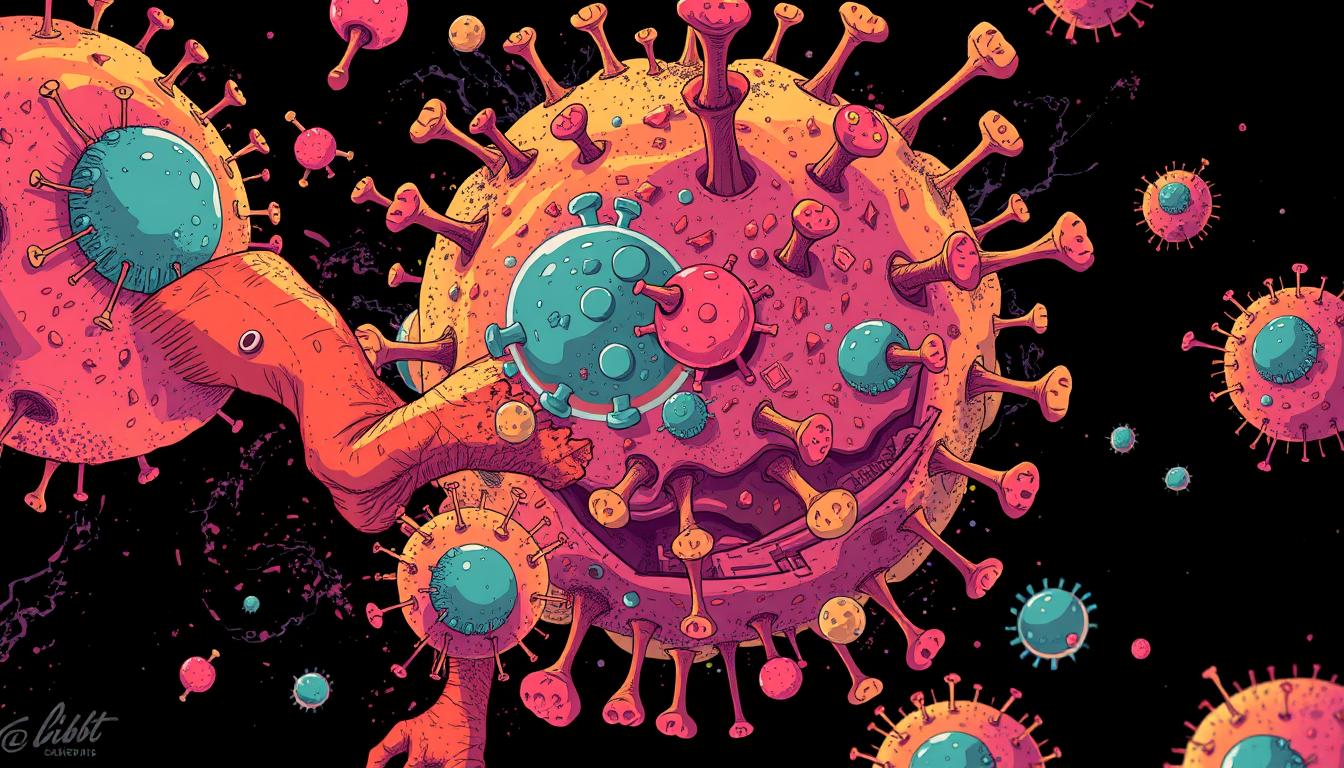
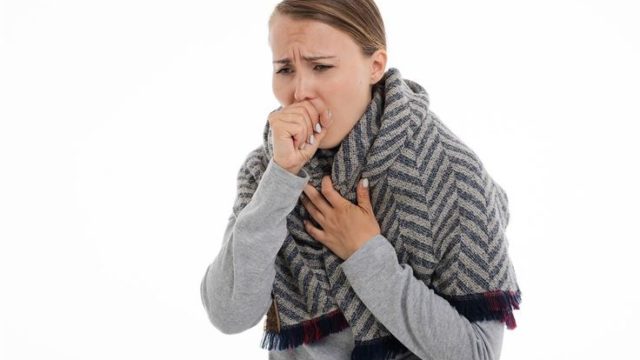
![14 Effective Home Remedies for Cough [Ultimate Guide]](https://healthyious.com/wp-content/uploads/2020/01/14-Effective-Home-Remedies-for-Cough-Ultimate-Guide-640x360.jpg)
